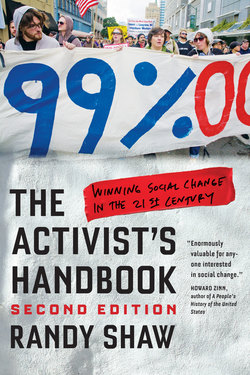Читать книгу The Activist's Handbook - Randy Shaw - Страница 7
На сайте Литреса книга снята с продажи.
ОглавлениеAcknowledgments
I have learned much about social change from my fellow activists. Whether through one-time meetings or common struggles, my discussions with activists have been essential to the insights expressed in this book. I have been particularly inspired in writing this new edition by the young activists whose struggles are described in the pages that follow. From the DREAM Activists to those battling sweatshop labor, to the students fighting for the environment and against rising college tuition costs, it is heartening to see new generations working for greater social and economic justice.
The Tenderloin Housing Clinic, which I co-founded in 1980 and have headed since 1982, has provided me with a perfect vehicle for implementing my ideas for achieving social change. When I wrote the original edition of this book, we had roughly twenty full-time staff; we now have closer to 250. I would not have had the mental energy to write this new edition without the strong, skillful leadership of Deputy Director Krista Gaeta, who administers much of the Clinic’s daily operations. This edition has greatly benefited from my discussions of activist strategies with other current and former Clinic staff. This group includes Tim Lee, Sam Dodge, Jeff Buckley, Dean Preston, Pratibha Tekkey, Jamie Sanbonmatsu, Paul Hogarth, and Clinic cofounder Chris Tiedemann. Mercy Gonzalez provided important clerical assistance.
Leroy Looper, owner of the historic Cadillac Hotel who died in 2011, offered me a model of integrity and street-smart strategic savvy that I have benefited from for over thirty years. He and his wife, Kathy, became great friends, and I have always tried to live up to Leroy’s ideals. I barely knew Sister Bernie Galvin when the original version of this book was published, but soon after we became close confidants and friends. We have talked regularly for over a decade to plan activist strategies for local and national affordable-housing campaigns. Fred Ross, Jr., whom I got to know well when writing my prior book on the farmworkers movement, has also proved a valuable strategic sounding board. This new edition is dedicated to my longtime friend Erik Schapiro. Our early work in the Tenderloin and our collaboration during his days as a supervisor’s aide and in the Agnos administration still reverberate in my thinking about activism today.
I am fortunate to have Naomi Schneider of UC Press as my editor. It was Naomi’s idea for me to write a new edition of this book, and she expressed continual confidence in its development.
My children, Anita and Ariel, were young kids when I wrote the first edition of The Activist’s Handbook. Both are now out of college and working in public schools to assist low-income students. Their personal experiences have added to the concern over testing-driven education “reform” that I discuss in this new edition. My late grandmother Hylda Levin was a New Deal Democrat and McGovern supporter who always vowed she would take me to Canada, if necessary, to avoid the draft. Although she died in 1975, her spirit lives on.
Finally, I am most indebted to Lainey Feingold, my wife and best friend since 1977. Lainey helped make me an activist and provided me with important and enthusiastic editorial assistance. This book could not have been written without her.
